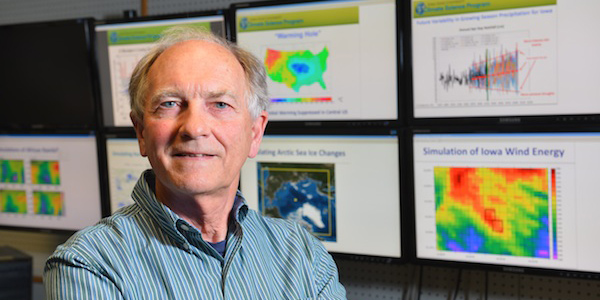
Forecasting Climate Change, Finding Ways To Adapt
Twenty-two years ago Gene Takle’s first study on climate change in Iowa was published in the Iowa Academy of Sciences. Using a NASA climate model, he explored a future climate scenario where carbon dioxide was doubled.
Referring to the study’s predictions, Takle, professor of agronomy and director of Iowa State’s Climate Science Program, says, “It showed there would be a general warming, more in the winter than summer; that’s happening. More at night than during the day; that’s happening. Three percent more precipitation; that’s happening—actually it’s been a little bit more than that. It also showed there would be a shift toward more precipitation in the spring and early summer and less in the fall and winter. We now have 13 percent more precipitation in the spring and early summer and 22 percent less in fall and winter than 50 years ago.”
Since that 1991 study, Takle and his graduate students have researched a multitude of climate-related issues. These include studying the impact of climate change on soil carbon; stream flow in the Mississippi River; United States food security; and the productivity of wind farms, an alternative to carbon-based fossil fuels.
“We’re conducting studies of a 200 turbine wind farm, for example,” says Takle. “We’ve measured wind speed in the vicinity of the wakes of the turbines. It’s what we would expect. There’s about a 30 percent speed reduction in the wind after the air has gone through the turbines. So our question is, if these guys take out a lot of energy, what about neighboring turbines? Will they experience a lower wind power? Indeed, they do.”
Takle says now their studies are connecting the meteorology to the energy produced—what happens when the wind is directly out of the west, for example. Takle has already begun discussions with Iowa State aerospace engineers about utilizing the data being collected from his studies to design best placement of turbines within wind farms.
His multi-disciplined view has produced collaborative projects with people across campus, from architects studying building design, to civil engineers working on roadway construction, and people in agriculture and sociology on a variety of climate change issues. He is excited about using Iowa State’s new super computer, called Cyence, which is capable of running “huge climate models” to assess the impact of Iowa’s future climate on natural processes and built infrastructure, such as the state’s 4,100 bridges.
Takle sees a connection to climate change within every area of study at Iowa State. When he taught his global change course a few years ago, he set out to draw students from an assortment of disciplines. “On the first day I would tell them all, ‘You should study climate change, because you will have something important to say about it. There are lots of things we need to understand from an engineering point of view; wind energy is one of them. But even if your major is philosophy or political science—there are a lot of moral and ethical issues associated with climate change. If we don’t get the politics right, we’re not going to get the rest of it right. Tell me what your major is and I’ll show you a link to climate change.’”
Takle and colleague Jerry Hatfield, director of the National Lab for Agriculture and the Environment, are the convening lead authors of the agricultural chapter of the newest National Climate Assessment, a federally mandated report to be released in 2014.
“It will paint a sobering picture of climate change globally and its impacts on the U.S. One of the key messages of the report is that the incidence of weather extremes will continue and will have increasingly negative effects on crop and livestock productivity because critical thresholds are already being exceeded,” Takle says. “For example, in western Kansas they are finding they are unable to raise corn even under full, continued irrigation. They cannot pump enough water to keep up with the increasing evapotranspiration demand of the plant, which it uses to cool itself down.”
Hatfield says all you have to do is look at crop production in Iowa over the last four years to understand the sensitivity of a cropping system to climate and weather.
“In 2010 we had an extremely wet summer and some of the highest night- time temperatures in late July and in August, which caused reduced yields in both corn and soybeans. In 2011 we had a pretty good growing season; then it turned extremely dry late in the year.
Everybody remembers ‘The Drought of 2012.’ And 2013 started off really wet and turned out extremely dry,” Hatfield says. “We can expect to continue to experience extreme weather variability within and among seasons, resulting in increased variability in crop production.”
Regarding adaptation to climate change Hatfield says, “If climate changed in an orderly fashion, we could easily adapt and change practices, but we’re seeing more and more variation within and among years. Given the extreme variability we’re seeing, it will take great effort to figure out how we build resilient cropping systems.”
Takle says agricultural experiment stations were established to research and respond to problems such as climate change. “Rather than wringing our hands, we’ll work together to find ways to reduce the causes of climate change and develop ways to live with changes we can’t avoid. That’s what a land-grant university does.”



